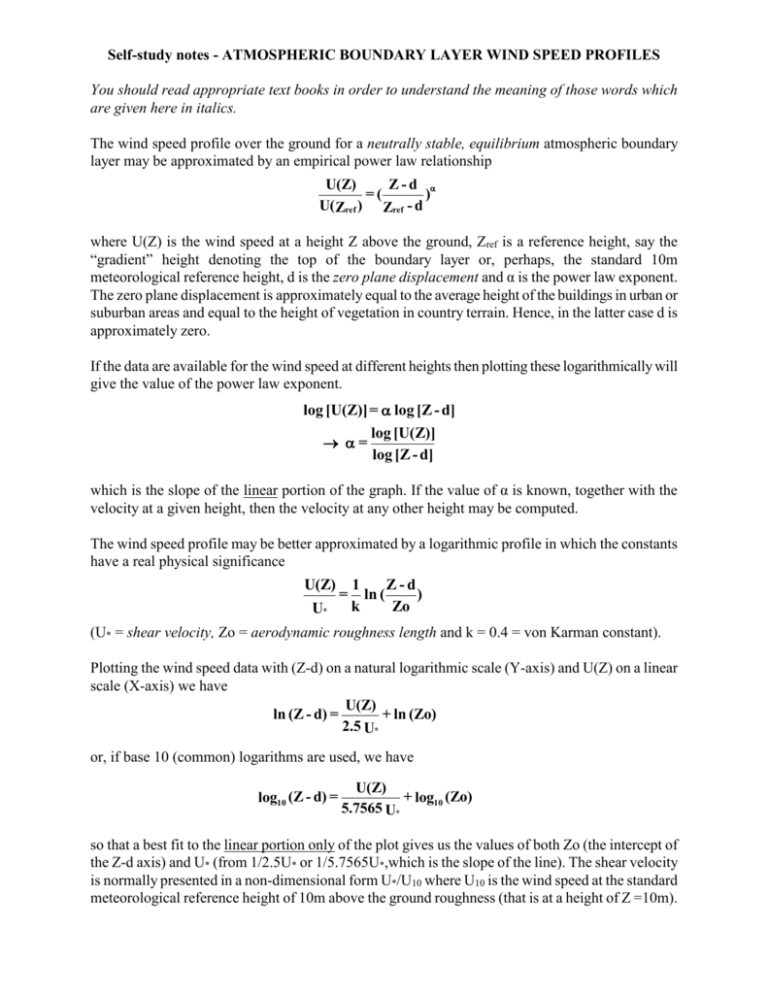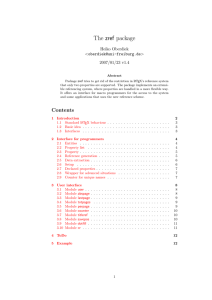ATMOSPHERIC BOUNDARY LAYER WIND SPEED PROFILES
advertisement

Self-study notes - ATMOSPHERIC BOUNDARY LAYER WIND SPEED PROFILES You should read appropriate text books in order to understand the meaning of those words which are given here in italics. The wind speed profile over the ground for a neutrally stable, equilibrium atmospheric boundary layer may be approximated by an empirical power law relationship U(Z) Z-d =( ) U( Zref ) Zref - d where U(Z) is the wind speed at a height Z above the ground, Zref is a reference height, say the “gradient” height denoting the top of the boundary layer or, perhaps, the standard 10m meteorological reference height, d is the zero plane displacement and α is the power law exponent. The zero plane displacement is approximately equal to the average height of the buildings in urban or suburban areas and equal to the height of vegetation in country terrain. Hence, in the latter case d is approximately zero. If the data are available for the wind speed at different heights then plotting these logarithmically will give the value of the power law exponent. log [U(Z)] = log [Z - d] log [U(Z)] = log [Z - d] which is the slope of the linear portion of the graph. If the value of α is known, together with the velocity at a given height, then the velocity at any other height may be computed. The wind speed profile may be better approximated by a logarithmic profile in which the constants have a real physical significance U(Z) U* = 1 Z-d ln ( ) k Zo (U* = shear velocity, Zo = aerodynamic roughness length and k = 0.4 = von Karman constant). Plotting the wind speed data with (Z-d) on a natural logarithmic scale (Y-axis) and U(Z) on a linear scale (X-axis) we have U(Z) ln (Z - d) = + ln (Zo) 2.5 U* or, if base 10 (common) logarithms are used, we have log10 (Z - d) = U(Z) + log10 (Zo) 5.7565 U* so that a best fit to the linear portion only of the plot gives us the values of both Zo (the intercept of the Z-d axis) and U* (from 1/2.5U* or 1/5.7565U*,which is the slope of the line). The shear velocity is normally presented in a non-dimensional form U*/U10 where U10 is the wind speed at the standard meteorological reference height of 10m above the ground roughness (that is at a height of Z =10m). The following note is for the case of a boundary layer over a smooth flat surface and is presented here for comparison with the “rough-wall” logarithmic law given above. “Smooth-wall” boundary layers also have a logarithmic region, described by: U(Z) U* = U Z 1 ln ( * ) C k where is the kinematic viscosity of the air and C is a constant, typically 5.5 or 5.1. In common logarithms, and taking C=5.5 this becomes (to two decimal places): U Z U Z 5.75 log * 5.5 U* Multiplying through by U*/Uref and also multiplying the term in the log brackets by Uref/Uref where is the freestream velocity at the top of the boundary layer (or some other reference velocity), gives U U U U UZ U Z 5.75 * log ref 5.75 * log * 5.5 * U ref U ref U ref U ref U ref Plotting U(Z)/Uref against log (Uref Z / ) gives a graph with a linear portion (the “log-law” region). By choosing different values of U*/Uref (typically between 0.030 and 0.045) we can plot straight lines of the form U(Z)/Uref = A log (Uref Z / ) + B, where A and B are constants computed from our chosen value of U*/Uref. The line that gives the best fit through the linear portion of the velocity profile gives the value of the shear velocity U*/Uref. This form of graph is known as a Clauser Plot. Questions (1) Why is the logarithmic representation of the boundary layer wind profiles better than the power law representation? (2) A boundary layer has a power law exponent of 0.17 and the wind speed at a height of 10 m above the ground roughness is 25 m/s. What would be the wind speed at a height of 50 m? (Answer: 32.9 m/s) (3) Meteorological measurements give the following data: Height above ground roughness, Z - d (m) Wind speed, U (m/s) 1.01 7.470 10.00 11.214 Use these data to estimate the values of the non-dimensional shear velocity and the aerodynamic roughness length. What would be the expected wind speed at a height of 40m with this representation of the velocity profile? (Answers: U*/U10=0.058, Zo=0.010 m, U40=13.478 m/s) (4) Detailed measurements in a suburban area give the following wind speed profile: Z - d (m): 5 10 20 40 100 200 500 1000 Speed (m/s): 16.9 20.8 25.2 29.1 34.8 40.6 50.4 63.9 Use graphical plots to determine the values for α, Zo and U*/U10. (Answers: α=0.21, Zo=0.30 m (approx), U*/U10=0.114) The following two questions require you to have completed the first Study Note concerning nondimensional parameters such as pressure coefficients and drag coefficients. (5) A tall building is subjected to a wind that has a velocity profile with a power law exponent of 0.17. The wind speed at a height of 10 m above ground roughness is 25 m/s. The external wind pressure acting uniformly on a 1 m x 1m square glazing panel whose centre is 50 m above the ground roughness has a pressure coefficient of -1.5. What is the total force acing normally on the glazing panel due to the wind? (Neglect internal pressures and take the density of air to be 1.24 kg/m3). (Answer: 1007 N) (6) A tower is constructed in the form of a free-standing circular section cylinder of diameter (D) of 1m and height (H) of 30 m. It is located within open terrain, such that the zero plane displacement is zero, and the power law exponent for the wind profile is 0.14. The drag coefficient for all parts of the tower (Cd) is 1.2 and the density of air (ρ) may be taken to be 1.24 kg/m3. If the wind speed (U) recorded at a height (Z) of 10 m above the ground is 35 m/s, calculate the overall wind-induced bending moment at the base of the cylinder. The best way to consider this problem is to think of the tower as a cantilever that is fixed at one end and subjected to a varying load along its length. We know that at any position along the cylinder the wind force per unit length is equal to F=Cd.D.½.ρ.U2 and we also know that U Z0.14. Hence, the contribution to the base bending moment from a section of unit length at any height Z is M=F.Z. So the total bending moment may be obtained by integrating the resulting function of Z over the whole height of the cylinder (from Z=0 to Z=H). (Answer: 489.3 kNm)











